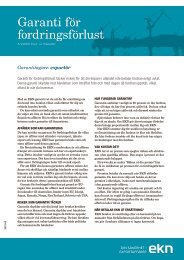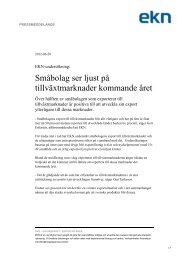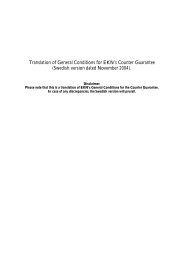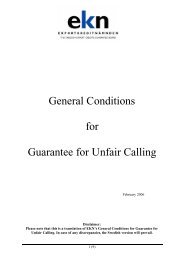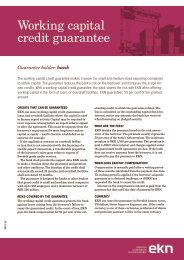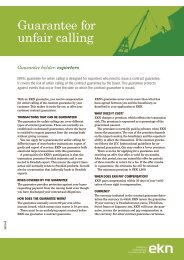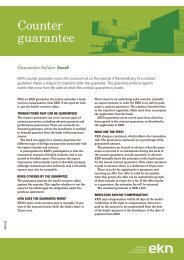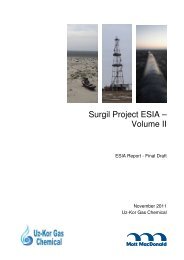Surgil ESIA Report - Volume III - EKN
Surgil ESIA Report - Volume III - EKN
Surgil ESIA Report - Volume III - EKN
You also want an ePaper? Increase the reach of your titles
YUMPU automatically turns print PDFs into web optimized ePapers that Google loves.
“O’ZLITINEFTGAZ” PC<br />
PFS “<strong>Surgil</strong> field complex costruction with valuable<br />
components retrieval”<br />
1.3.5 FLORA AND FAUNA<br />
Modern condition of Aral area in deserted zone defines character of the vegetative<br />
cover of investigated region. In connection with modern natural processes in the territory of<br />
Aral Sea there is observed degradation of the vegetative cover in the region of works. One<br />
of the heaviest factors defining a modern condition of biocenose of Aral area is<br />
desertification process.<br />
The greatest distribution in the territory was obtained by such types of<br />
anthropogenous desertification as degradation of vegetation and salinization of the soils,<br />
caused by drawdown of Aral Sea and overregulation of the deserted Amu Darya and Syr<br />
Darya rivers drainage.<br />
All dried up area is located in a zone of deep ecological crisis with strong degree of<br />
desertification. Prevailing type of desertification – salinization of the soils, but along with it<br />
thre is noted degradation of unstable vegetation. Display of desertification process are huge<br />
spaces of s alkaline lands, inequality in overgrowing, prevalence of annual species of plants,<br />
their weak associativity, insignificant participation of perennial plants, incomplete<br />
development of biohorizons, intensification of mineralization degree of the underground<br />
waters and their decrease.<br />
Ecological situation on the drained sea bed is critical and strained. The same<br />
conditions are in the regions of modern Syr Darya delta and throughout Amu Darya delta.<br />
According to literary data, there are 244 species of flora representatives in Aral area<br />
in the territory of Uzbekistan. Among the most widespread families there are presented the<br />
following: buzgun, compositae, cereal, tamarisk, sedge, chenopodiacious, crucials and<br />
legumes.<br />
A high specific variety of vegetation is concentrated in the deltas of Syr Darya and<br />
Amu Darya rivers. However, this variety is reduced now in connection with overregulation<br />
of the rivers drainage and desertification of meadow-tugai vegetation. So, thickets of<br />
endemic Kazakhstan cane were widespread through Aral shallow gulfs and lakes in Syr<br />
Darya delta. Now this species meets very seldom. Hydrophytic vegetation of Aral Sea shoal<br />
(reed, zinnikelnya, rupee, naiad) has disappeared completely. Fragments of hydrophytic<br />
communities have remained in small lakes of Syr Darya and Amu Darya deltas, on the sites<br />
of pinching-out of underground waters in northern drying of Aral (Karabulak).<br />
The flora of reservoirs (Aral Sea and lakes) is very poor and makes 13 species of the<br />
higher plants. They are representatives of reed mace, pondweed, eelgrass, zannikelch, naiad<br />
and sedge families, during sea contraction they be found as the most vulnerable, than other<br />
groups of plants.<br />
Changes of environmental conditions have caused impoverishment of flora specific<br />
composition (as in qualitative and quantitative relations). Most widespread species of plants<br />
in the region of works are the following: tezgun, wormwood, white-ground wormwood,<br />
turan wormwood, sand wormwood, glasswort, saltwort, keyruk, locoweed, camel's-thorn,<br />
aperec, tamarica, tamarisk, karaborak, yerkek, biyurgun, tastibiyurgun, licorice, black<br />
<strong>Volume</strong> 2. Part 1. EIS Project for <strong>Surgil</strong> field construction<br />
25



